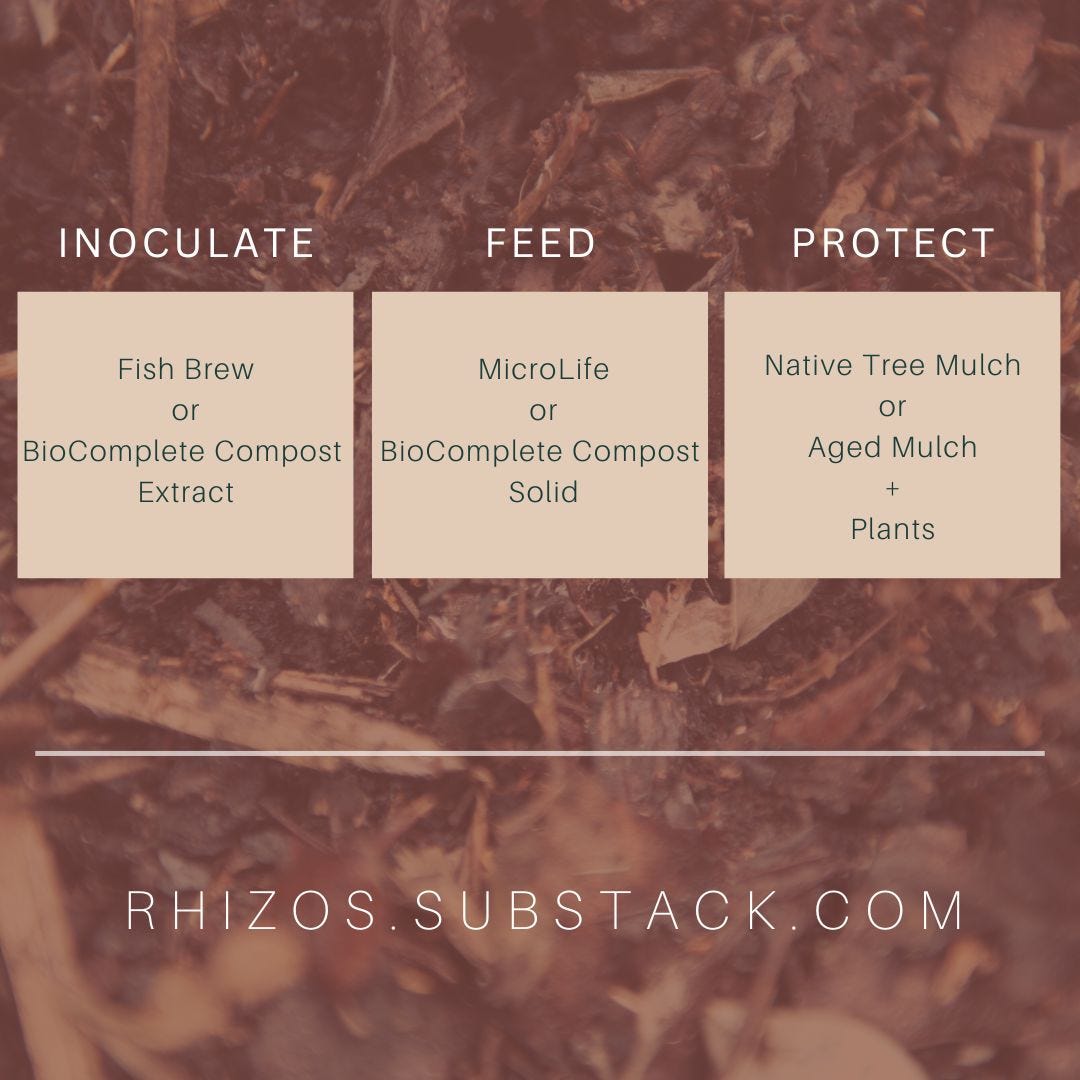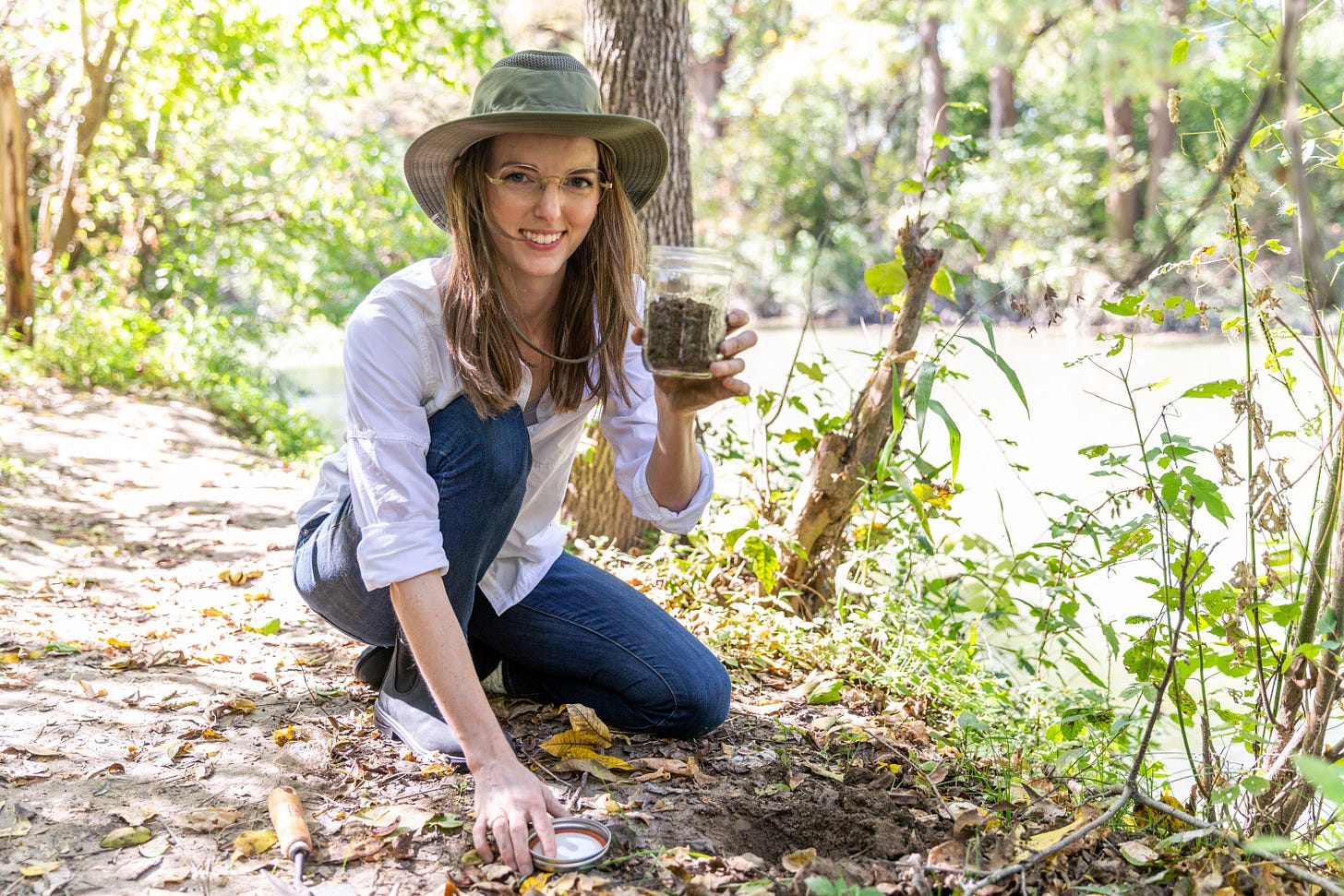Practical Tips: DIY soil health
Actionable items for stewarding your soil and landscapes this spring! 🌼
Whether it’s a lawn, garden, or agricultural field - we’re often scrambling to make decisions for our landscapes this time of year.
My friends and family are starting to hit me up for advice, so I thought I’d share with you what I’ve shared with them.
non-disclaimer: I am NOT an affiliate for any of the products mentioned in this post. These are genuine suggestions based on my personal and professional experiences.
What’s the general process of nurturing soil?
The principles of improving soil health in most small scale contexts are:
Inoculate
Most landscapes we interact with have been disturbed (in an ecological sense) in some way in relatively recent history - whether it was the excavation at the time your lot was developed, compaction from foot traffic, overgrazing from generations before, or even the fencing that separates your land from surrounding areas - these factors can all negatively impact soil life long after the occurrence.
To reintroduce biodiversity to the rootzone we have two options:
wait on a geological timescale and likely die before seeing any significant improvements 🪦
mindfully reintroduce microorganisms to the soil 💯
Increase OM
Disturbance often leads to a significant loss of organic matter (OM) - an important source of habitat and food for microorganisms and subsequently, plants.
To support microbes we introduce to our landscape, we must provide them sources of organic matter.
Protect
Just like most living things, beneficial soil organisms don’t like to be pummeled by rain, scorched in the sun, or blown around in the wind.
To maintain microbial activity in our landscape, we must protect our microbes.
For example, mulching bare soil and/or planting groundcover, is as essential to the safety of soil organisms as shelter is to humans.
We can go about meeting these principles in many different ways.
Today, my recommendations are tailored to laypeople
Edit: since I couldn’t help myself, I’m also including a section with considerations for soil professionals 😉
I don’t expect most people to make their own BioComplete composts
That is, a biologically active soil amendment - the antithesis of industrially made GOM/ground-up organic matter. Nor do I expect everyone to be able to find a BioComplete compost to purchase (unfortunately, though I expect this to change in time).
For this reason, today’s recommendations are for products that can easily be purchased in the U.S. (again, I have no affiliation - with the products that is, my affiliation with the U.S. is as a citizen 🤪).
Please know, if you CAN source a BioComplete Compost and are interested in handling it to make extracts - definitely do that instead.
For folks in other countries, I encourage you to consider the principles discussed and find sources in your region that honor them… then come share your sources/materials with us here! ;)
What to do when you can’t get your hands on BioComplete Compost:
Firstly, I recommend using FishBrew “Rise and Thrive” or “Bold FLO” for inoculation
For planting or seeding a landscape: apply this just before and after planting/seeding at the labeled application rate (or even better, you could make a storage tote worth of fish brew and dunk the roots of transplants).
To establish new plants: Apply 1-2x times a month for the first few months of establishment
To maintain an established landscape: Apply 2x per year - once in fall and spring.
Purchase info: this is available for purchase on their online store.
Why FishBrew?
Consider this product primarily an inoculant of protozoa (bacteria predators) into the environment that will prey on bacteria and cycle nutrients to plants.
FishBrew has a better shelf-life than other biological liquid products I’ve evaluated 🔬 because it contains diatoms which produce oxygen, even in light deprived environments, allowing the liquid to maintain aerobic conditions.
Diatoms’ oxygen-making benefits goes far beyond the bottle - this function is likely to improve oxygen levels in compacted soils, allowing beneficial biology to begin aggregating/building structure in parts of the soil that need it most.
Furthermore, diatoms are a great source of silicon - a nutrient that, despite its lack of status as an “essential plant nutrient”, is becoming more intriguing the more we learn from research examining its role in plant health (if interested, see references for more!)
Secondly, I'd also use MicroLife products as a replacement for synthetic fertilizers
Product: you can contact MicroLife to get a specific recommendation for various plants and environmental contexts, but in most cases you can't go wrong with their purple bag of humates.
Humates: 2x per year in fall and spring at the application rate listed on the bag (ideally apply just before a rain event, or schedule a good soaking irrigation cycle to activate this granule amendment)
Why MicroLife?
Consider this product primarily organic matter that provides food and homes for microbes, providing them safety and comfort so they'll want to stay and make babies in your landscape!
It is also a good source of fungal inoculant.
Purchase info: MicroLife has some retailers throughout the southern US (see their website for locations), and are also available to purchase on Amazon.
Why Use Both?
MicroLife does have beneficial microbes, but it is not as meaningful of an inoculant as Fish Brew and vice versa - Fish Brew doesn't have as much organic matter as MicroLife. This is why I recommend them both - a one, two punch.
Bonus: wtf do I do about weeds?
Remember, weeds are early-succession plants just doing their job. But that doesn’t mean you have to let them roam freely.
It’s all about timing…
I like allowing weeds to grow (in areas where the HOA can’t see ‘em) through their vegetative state and then I mow/whack them as they’re flowering / just before they go to seed.*
I find a slightly higher mow setting is best, because if you cut them too low they tend to flower super close to the ground in their next cycle, making it harder to trim the next time.
Trimming before seeds set helps prevent them from proliferating too much, while allowing them to grow provides exudates to the soil and habitat and food to insects, especially when the grass and other plants are still dormant.
You’ll learn which weeds like to proliferate via roots if they’re growing in numbers without going to seed. Those are the only ones I keep an eye out for to uproot at the first sign of them.
Keep perspective and be consistent:
The more you focus on nurturing the soil instead of fighting weeds, the less weed pressure you’ll ultimately experience.
*Pro-Tip: I bag the clippings as I go, dry them on a tarp in the sun, and save them as greens for my next compost build 🤓
Industry Folks / Enthusiasts
Hot Take: compost extract > tea
The more tea I look at under the microscope, the more inclined I am to advise people to just make extracts - there are fewer variables, it’s more fool-proof (not that anyone is a fool who goofs up a tea!).
I don’t recommend brewing tea unless you have a microscope. This is because, when we add microbial foods for a brew cycle, it’s really easy to unintentionally breed a lot of bacteria.
We don’t want to be inoculating soils with low F:B ratios (i.e. a lot more bacteria than fungi). We mostly want teas to be a great source of bacteria-predators and fungi.
The only way to know if your tea has these target organisms is to sample the tea throughout the brew cycle by evaluating at 400x.
BTW, you can add some microbial foods to your extracts at the time of application; it’s the brew cycle that tends to thwart people.
Mulch
Consider having a heap of woodchips on your property that you lightly feed fungal foods throughout the year - pull from this any time you need to top off your mulched areas or use it as needed in composting recipes.
That’s all from me on that!
Go make some soil 💫
-Andie
Was this helpful? Send it to someone you know or consider making a pledge!
References
Coskun, D., Deshmukh, R., Sonah, H., Menzies, J.G., Reynolds, O., Ma, J.F., Kronzucker, H.J. and Bélanger, R.R. (2019), The controversies of silicon's role in plant biology. New Phytol, 221: 67-85. https://doi.org/10.1111/nph.15343
Piotrowski, K., Romanowska-Duda, Z. & Messyasz, B. Cultivation of energy crops by ecological methods under the conditions of global climate and environmental changes with the use of diatom extract as a natural source of chemical compounds. Acta Physiol Plant 42, 146 (2020).https://doi.org/10.1007/s11738-020-03135-8









